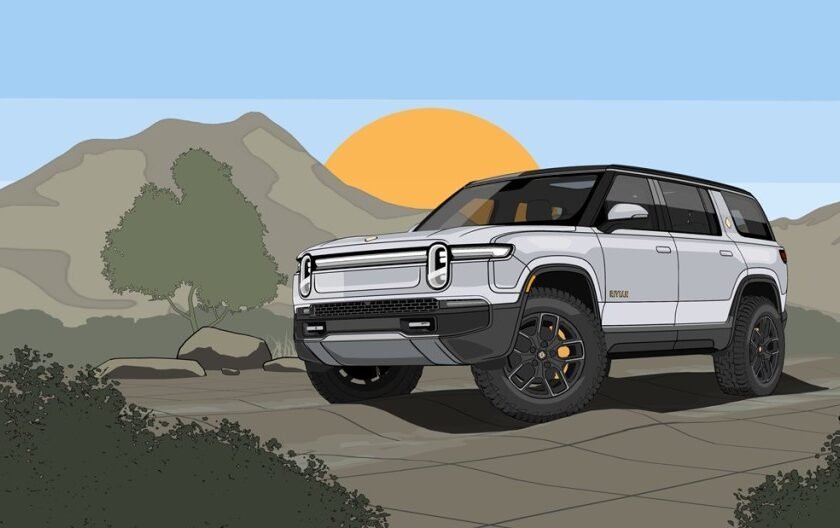Rivian is using the Epic Games’ Unreal Engine for making games to power the new display user interface in its latest R1 electric vehicles being unveiled today.
With Rivian’s introduction of its second generation R1 vehicles, it is expanding its use of Unreal Engine from the driver’s display to the full infotainment center across its existing fleet.
“With this playful new user interface, we’re personalizing the driving experience to Rivian owners in a way that harnesses their adventurous spirit,” says Wassym Bensaid, Rivian’s chief software officer, in a statement. “Every pixel of the dynamic interface helps Rivian owners feel that the software in their car is bespoke for them, with real-time renders reflecting the exact spec of the vehicle being driven.”
This experience plays out in nine different drive modes. These styles transport drivers from the mountains to the desert—and even feature an updated camp mode complete with the Rivian tent and softly flickering campfire.
Lil Snack & GamesBeat
GamesBeat is excited to partner with Lil Snack to have customized games just for our audience! We know as gamers ourselves, this is an exciting way to engage through play with the GamesBeat content you have already come to love. Start playing games now!

“Rivian has been able to push entirely new artistic boundaries with Unreal Engine to redesign this user experience in a bespoke illustration style,” explains Jeff Hammoud, Rivian’s chief design officer, in a statement. “The level of craftsmanship for the look and feel, running in real time, in vehicle, was in large part thanks to the tools and performance targets that only Unreal Engine can achieve today.”
“Every physical part of the vehicle must be represented in the correct way, from the tires to wheels, cladding, paint, windows, and trim. We went through a ton of variations for the vehicle lines, how they are placed on the vehicle, and how they’re weighted. Lighting became a unique challenge, as it’s not lit in the traditional sense, but we still need to produce reflections on the vehicle because after all, it is still covered in paint and glass,” adds Andreas Poser, Rivian’s visualization lead. “We’re using a lot of custom shaders to bring this to life, and we owe the final look to the rapid iteration we were able to achieve with Unreal Engine materials.”

Inspired by visual storytelling that represents the best of what’s possible in the entertainment world, Rivian designers have embraced Unreal Engine for its human-machine interface (HMI) display since the release of its first vehicle, the R1T, in October 2021. This latest update delivers a first-of-its-kind look with scenes that are alive, enabling drivers to interact with them via a touchscreen interface.
“Unreal Engine not only helped us create the appearance of the drive modes in a very agile and iterative way, but it also allowed us to make each mode more dynamic. For example, any mode can smoothly transition into another mode the driver chooses. And even when the mode settles, the vehicle and environment around it remain dynamic. The viewer will see clouds, grass, flowers, and trees moving. They can even touch the vehicle with two fingers and pivot it around, and the environment moves with it in three dimensions,” said Eddy Reyes, a senior manager on Rivian’s Embedded Software Experiences team, in a statement.
With both design and engineering teams working in Unreal Engine, this new reimagined UI experience was brought to life in just six months. The teams put a lot of effort into the micro-animations in each scene; from fireflies to dust clouds, everything went through several design and optimization cycles.

“It’s a fully interactive experience, and none of it can be baked. For instance, in the drive modes app, you can switch between any of the nine modes instantly. We can’t plan for the combinatorics, due to the numerous animations involved, and scaling would pose challenges. We have to dynamically construct the worlds during these transitions, even if the driver changes their mind halfway through. These rules influenced how we constructed and managed the world around the vehicle,” said Reyes.
Unreal Engine sits at the heart of digital transformation for Rivian, enabling designs that use every inch of real estate to deliver excellent features—always with a healthy dose of playfulness and charm. This new UI design in Unreal Engine opens the opportunity to easily refresh the in-cabin experience and features over time for Rivian owners—a community of drivers that are quick to adopt each new over-the-air (OTA) update.
By building assets in Unreal Engine, manufacturers establish a single source of truth for designs that can be used across various functions. Rivian sees the potential in bringing this same look and feel to other surfaces and will continue to raise the bar for what’s possible for the future of driving.
With Rivian’s introduction of their second generation R1 vehicles today, it’s expanding its use of Unreal Engine from the driver’s display to the full infotainment center across its existing fleet. Inspired by visual storytelling that represents the best of what’s possible in the entertainment world, this latest HMI update delivers a first-of-its-kind look with scenes that are alive, enabling drivers to interact with them via a touch screen interface.
With both design and engineering teams working in Unreal Engine, this new reimagined UI experience was brought to life in just six months. The teams put a lot of effort into the micro-animations in each scene; from fireflies to dust clouds, everything went through several design and optimization cycles.
Unreal Engine sits at the heart of digital transformation for Rivian, enabling designs that use every inch of real estate to deliver excellent features—always with a healthy dose of playfulness and charm. This new UI design in Unreal Engine opens the opportunity to easily refresh the in-cabin experience and features over time for Rivian owners—a community of drivers that are quick to adopt each new over-the-air (OTA) update, Rivian said.
VB Daily
Stay in the know! Get the latest news in your inbox daily
By subscribing, you agree to VentureBeat’s Terms of Service.
Thanks for subscribing. Check out more VB newsletters here.
An error occured.




